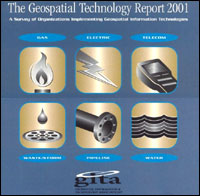The GITA report that was compiled is not considered scientific or a statistically accurate report.Rather it was based upon the number of respondents who sent back  questionnaires to GITA.In terms of this report, 147 companies submitted 157 survey responses.The responses however present a very comprehensive view of the "utilities industry," which for GITA purposes is comprised of the telecommunications, gas, pipeline, and electric submarkets.
questionnaires to GITA.In terms of this report, 147 companies submitted 157 survey responses.The responses however present a very comprehensive view of the "utilities industry," which for GITA purposes is comprised of the telecommunications, gas, pipeline, and electric submarkets.
The vendor market share numbers are based solely on the projects reported in the survey responses, not on dollar volume of the project costs.The ability to accurately depict the GIS market is only an art.Since the majority of vendors are private companies, GITA can do no more than it can with the data it has at its disposal, and they have done a good job in trying to fairly assign market leadership.Yet, I wonder if any attempt to characterize the GIS market is futile.There are no accounting standards that allow this calculation to be "apples to apples." Depending on how each vendor computes revenue from direct and indirect sales, the door is wide open for interpretation of who has the larger market share.Using the number of projects awarded as a basis for computing market share provides one measure.It is an indication of the success of competitive bidding.It does not, however, reflect the size of the award or deployment effort.One vendor could have a low number of awards, but which could be considered very large enterprise implementation efforts, with higher revenue potential.From the report, the market leaders are GE Smallworld in Gas, ESRI in Electric, Pipeline, and Water/Sewer/Storm, and Intergraph in Telecommunications.However, the "Other" category has the highest total market share for both Telecommunications and Pipeline.
In the category that looks at the leading operating system, Microsoft Windows is the clear winner having 77% of total; 4% for UNIX and a 16% mix of UNIX/Windows.I interpret the data somewhat differently than GITA that claimed there is room for UNIX as a server-based solution.I disagree; I think the introduction of Windows XP will just about kill any further thoughts of heading down the path of UNIX if one is inclined to start from scratch.The market share for UNIX-based GIS solutions has declined continuously since the mid-90s and Microsoft has proven that its operating system and database solutions are both cost effective and robust-enough to handle most spatial applications with the exception of the needs by large enterprises.
Taking a look at the applications being deployed and on which technologies, there is little correlation among the industries.However, it is clear that much spatial information management is directed toward maintaining of the landbase and infrastructure knowledgebase.Most companies are implementing Internet applications and also appear to be customer focused with deployment of customer relationship management (CRM) and customer information system (CIS) software.
The GITA report is a very thorough industry compendium if you have a need to know about spatial information management for the utilities industry.It covers much in the way of landbase and facilities management challenges and should be considered a "must read" for executive personnel in these industries.